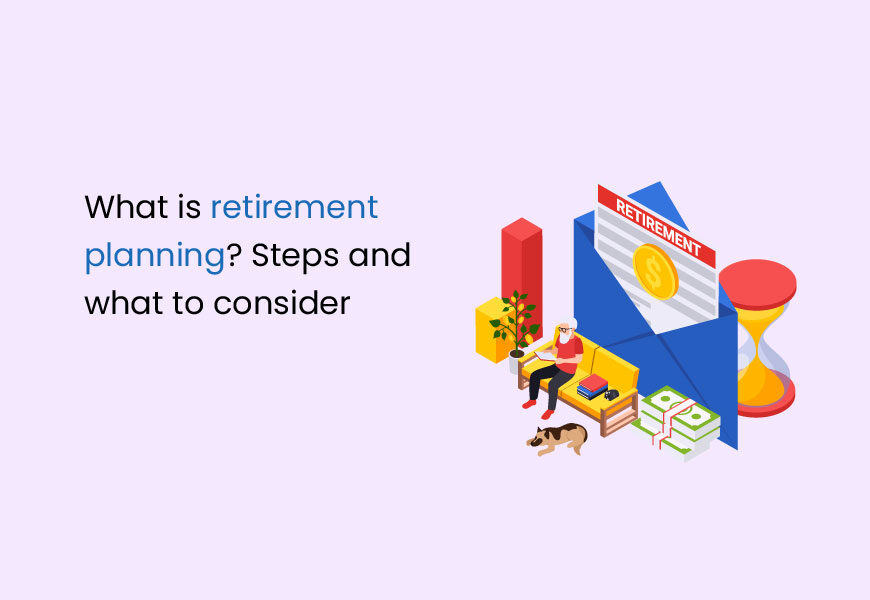What Is Retirement Planning?
Retirement is one of the most important milestones in a person’s life bringing with it major life changes. While it gives you freedom, it also brings with it the challenge of maintaining your lifestyle.
This is where retirement planning comes into play. Despite its importance, almost 76 per cent of people expect a comfortable retired life, according to the International Journal of Creative Research Thoughts, only 33 per cent of people are putting aside money to fund this phase of their lives.
So, how do you become retirement-ready and avoid making costly mistakes? Continue reading to know the how and why of strategized retirement planning, with a special focus on its importance for informal workers.
Understanding Retirement Planning
Retirement planning is much more than just planning your finances for a post-retirement life. It also includes personal planning to determine your satisfaction with the life that you envisioned.
It is what one does to prepare for life once your paid work ceases to offer you remuneration.
Here is what it includes:
- Knowing when you will retire and decide the time at which you want to start saving.
- Setting realistic expectations about your post-retirement life.
- Know the best ways to begin investment for retirement planning and monitoring them regularly.
- Setting an emergency fund, especially for medical emergencies.
- Have a sound tax strategy to prevent erosion of your savings.
- Know the effect of inflation on your purchasing power.
Here are some post-retirement pitfalls to avoid:
- Not having a strategy to align with your defined goals.
- Overlooking medical expenses, especially those related to medical emergencies.
- Retiring with excessive debt.
- Not having a prudent asset allocation strategy and trading too much without realising your risk tolerance.
How Much Do You Need to Retire?
When asked how much money one needs for retirement, different people give different answers. While some will say you need X lakhs or crores as retirement corpus to live your retired life comfortably, others will say you should have atleast 60-80% of your monthly income at retirement to live comfortably. Some professionals also believe that people are not saving enough for retirement and will be forced to make adjustments to their lifestyle post-retirement.
While all these are valid arguments, the amount of money needed to retire depends on various factors, including your desired lifestyle in retirement, your current age, your expected lifespan, your retirement goals and the cost of living in the area where you plan to retire, among other factors. You will also have to factor in for new expenses such as geriatric healthcare, leisure expenses, etc.
This is why you need to determine the specific amount of money you need to retire comfortably with the help of a financial advisor based on your individual circumstances and goals. Further, retirement planning and saving should start as early as possible.
Why Is Retirement Planning So Important?
According to an Economic Times report, 7 out of 10 Indians expect their children to support them after retirement. While your children may shoulder your expenses, in the long run, it may lead to a strain on their expenses and ultimately friction in your relationship with them.
You will be financially independent
Retirement planning allows you to determine your post-retirement lifestyle and the involved expenses. When you plan your expenses well in relation to your savings and income, you can achieve complete financial independence and live comfortably without having to depend on anyone else.
You have a steady flow of income
After retirement, you not only need a corpus but also a steady income flow to take care of your basic and regular expenses. This regular cash flow ensures liquidity, safety, and the confidence to lead a stable life.
Sizing up your expenses and having a low-risk savings program in place helps you have a monthly cash inflow.
You won’t be stressed
Not knowing where your money is coming from is a huge source of worry. When you plan your retirement planning investments, you ensure your financial wellness. This, in turn, lowers your stress levels and prevents stress-related health issues such as migraines, diabetes, and even heart disease.
You will not pay more taxes than necessary
Retirement is a time when you don’t have a regular source of income. When your retirement savings and income are taxed, it may create a huge dent in your finances.
When you do retirement planning, you can devise strategies for controlling your taxable income and enjoying better returns.
You can make better decisions now
With your retirement planning in place, you can make better financial and career decisions. For instance, when you know that you have invested well, you can follow your dream of becoming an entrepreneur or even go for higher studies.
It’s easier to plan for exigencies
One of our biggest fears is being asked out of our job and not having a financial safety net. When you have planned your investments for retirement planning, you can be in a much better position.
In fact, you can even choose to take voluntary retirement and focus on things that you really want to do.
Steps To Retirement Planning?
Understanding the time window
This includes your current and retirement age. The longer the gap between the two, the more is your risk appetite. This allows you to invest in high-return financial instruments. Understanding this also helps you know the impact that inflation will have on your purchasing power and fund pool when you reach your retirement age.
Setting your retirement planning goals
This includes setting realistic expectations about your spending habits post-retirement. It is always prudent to account for unforeseen medical expenses or those mortgages that you haven’t paid. It also helps to plan for your bucket lists while setting these goals.
Starting early
Investment for retirement planning starts long before you actually retire and requires considerable planning. Delaying it may mean compromising on your goals and worse, being dependent on others to meet your expenses.
Reduce unnecessary expenses
Not just retirement planning investment, you also need to cut down on avoidable expenses. These may include entertainment, dining, and impulsive purchases.
This helps you invest more and reach your retirement planning goals faster.
Track and review your retirement planning investment
Tracking your investment and monitoring it at regular intervals is important. It helps you stay on top of your finances vis-à-vis the changing market scenario including taxes and inflation rates.
Stages of Retirement Planning
Retirement planning must start at the earliest possible in order to create a sizeable corpus and ensure financial independence post-retirement. There are certain things to keep in mind while planning for retirement at different stages in your life.
Young Adulthood (Ages 21–35)
Young adults may not have a lot of money to invest but the sizeable time period available enables them to compound their savings and augment a large enough retirement corpus. Compound interest enables those who start retirement planning early to earn more interest. Plus, the greater risk appetite at this stage also means that you will be able to invest in high-returns instruments such as equity.
Young adults can invest smaller amounts, say a few thousands, monthly in growth-oriented schemes such as diversified equity funds and equity-based mutual funds to earn high value overtime. However, if you started saving only at 40 or 45, you will have to pay more monthly to make up for the lost time and create a solid retirement corpus in addition to the existing financial commitments such as loan repayments, insurance premiums, etc.
Mid-Life (36-50)
The 40s are typically when people start to think about retirement planning and it is the best time for aggressive savings as you will have more income at your disposal but limited time. However, it is still not too late to start retirement planning.
In this stage of life, you will already have several financial commitments such as loans, credit card debt, insurance premiums, increasing medical bills, the need for disability and life insurance, familial commitments (such as children’s education) and so on. Your risk appetite will also reduce and will be moderate at best at this stage of life. So, you will have to opt for more balanced funds and invest greater sums of money.
Later Mid-Life (50-65)
It is daunting to start retirement planning investments with just 5 or 10 years before retiring. At this stage, your financial commitments shoot up considerably while your risk appetite shrinks. You will have to invest more money in safer investment schemes to create a sizeable corpus for retirement.
Factors to keep in mind while investing for retirement planning
There are some crucial factors that you need to consider before beginning your retirement planning investment. These include:
Risk tolerance
Before doing any kind of retirement planning, you need to assess your risk appetite. People with higher income sources can afford to more risk. It mainly depends on factors such as your financial goals, time left for your retirement, and the lifestyle that you want after you stop working.
Impact of inflation
Inflation rates have a major eroding effect on your savings and purchasing power. This becomes an even more important consideration post your retirement. To ensure that you aren’t affected by it, you should ensure that your money grows at a higher rate than that of inflation while choosing your investments.
Balanced portfolio
Diversification is the key when it comes to reducing your risk. It makes sense to balance your portfolio and create a mix of low and high risk plans corresponding to their yields.
Affordable investments
While doing retirement planning and investing, never go beyond what you cannot afford. Invest in solutions that fit your budget and yield good returns at the same time. You can work with a financial planning advisor to make your retirement goals achievable.
Mode of payout
Liquidity is an essential consideration while planning for investments for retirement planning. For instance, you may need cash to pay for your child’s college fee or any unforeseen medical expense.
Ensure that you look through the fine print of your investment for lump sum payouts or a yearly guaranteed payout.
Other Aspects of Retirement Planning
Remember that retirement planning is more than just considering your monthly income and expenses to create a corpus. You must look at your complete financial picture to determine how much and what to invest in. The other aspects to consider include:
- Housing: Buying one’s own home is an important investment in India and considered one of the biggest assets. So, you need to factor in your housing loans and the value of your home itself in retirement planning.
- Tax planning: Your investments need to be tax efficient while you are creating your retirement corpus. However, your retirement plan also needs to account for the taxes that you will have to pay on your income post-retirement.
- Insurance: Retirement planning must help you to protect your assets. From increasing medical bills to rising cost of living, you may not be able to bear suddens or emergencies if your retirement is not planned well. And you will be forced to sell or mortgage assets to meet these needs. This is why retirement planning should include life, medical and long-term care insurance.
Retirement Planning and the Informal Labour Force
According to an International Labour Organization study, close to 90 percent of the workforce in India is informal and the Government of India data places the number at 93%. Without social security, they face the grim reality of falling health and poverty in their later years. Add to this that they are underpaid and have unstable employment.
But this has all changed with solutions like TankhaPay that helps formalise the wages of these informal workers and brings them under the ambit of social security schemes like Employee Provident Fund (EPF), which serves as a critical retirement benefit. It has several advantages including:
- Access to healthcare when needed and reduction in out-of-pocket expenses leading to a better quality of life.
- A reliable source of income after their retirement so that they don’t have to force themselves to work.
- It increases their motivation and commitment towards their employees. You have a more productive and happier workforce, which helps you achieve your goals.
Conclusion
With TankhaPay, you can become a socially responsible employer and take care of your informal workforce’s dignity.
Download the app now to give your workers a chance to have a better life.














